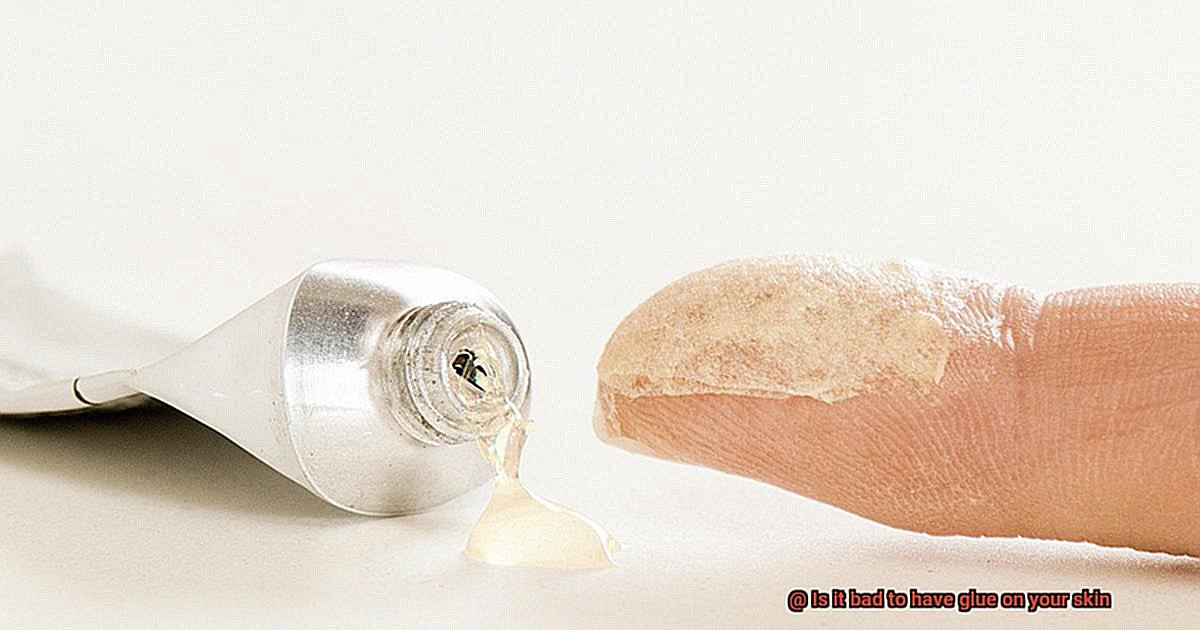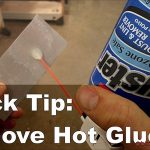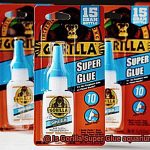Got some glue stuck on your skin?
Whether it’s from a craft project gone wrong or just a weird habit, you might be wondering if it’s really a big deal. Well, I hate to break it to you, but having glue on your skin can actually be pretty bad news.
In fact, it can cause all sorts of problems, from irritating your skin to triggering nasty allergies. So before you get too comfortable with that sticky situation, let’s dive into the dangers of glue on your skin and why you should think twice before letting it linger.
Trust me, your skin will thank you for it.
Different Types of Glue and Their Effects on the Skin
Contents
- 1 Different Types of Glue and Their Effects on the Skin
- 2 The Potential Health Risks of Glue Exposure
- 3 Signs and Symptoms of Glue Exposure
- 4 How to Avoid Accidental Glue Exposure
- 5 What to Do if Glue Comes into Contact with the Skin
- 6 How to Remove Glue from the Skin Safely
- 7 Tips for Choosing Safer Alternatives to Glue
- 8 When to Seek Medical Attention for Glue Exposure
- 9 Conclusion
Glue is a remarkable substance that can bond objects together, but it’s important to be aware of its potential effects on the skin. In this article, we will explore various types of glue and uncover how they can impact your precious skin.
Super Glue – The Fiery Bond:
Super glue, also known as cyanoacrylate adhesive, possesses incredible bonding power, creating a strong hold in mere seconds. However, this sticky superhero isn’t so friendly to our skin. When super glue comes into contact with our delicate skin, it can cause irritation, redness, and even burns. That’s because super glue reacts with the moisture in our skin, generating a fiery heat sensation. Ouch.
Craft Glue – A Milder Companion:
Craft glue is a creative companion commonly used in arts and crafts projects. Unlike super glue, craft glue has a milder formula that reduces the likelihood of immediate irritation or burns on the skin. However, it’s essential to exercise caution as some individuals may still experience mild allergic reactions or skin irritation after extended exposure to craft glue.
School Glue – The Safe School Staple:
Remember the white or liquid glue you used in school projects? That’s school glue. Made from polyvinyl acetate (PVA), school glue is generally safe for use on the skin. While it may leave your skin feeling sticky for a while, it won’t cause significant harm or irritation. Simply wash it off with soap and water, and you’re good to go.
Medical Adhesives – Healing Helpers:
Medical adhesives are specially designed for use on the skin. They are gentle and safe, minimizing the risk of irritation or adverse reactions. These adhesives are often used in wound closure or surgical procedures and can withstand exposure to moisture and body fluids without losing their stickiness. Remember, though, medical adhesives should only be used under the guidance of healthcare professionals.
Now armed with knowledge about the different types of glue and their effects on the skin, you can make informed decisions and protect your skin from any sticky situations. Exercise caution when using super glue, opt for craft glue for creative projects, and keep school glue on hand for safe and easy cleanup. And if you ever need medical adhesives, trust in their healing power.
The Potential Health Risks of Glue Exposure
The Potential Health Risks of Glue Exposure
Glue, a handy tool found in almost every household, is a staple for craft enthusiasts, DIY gurus, and those who love getting creative. But amidst the excitement of sticking things together and getting artsy, it’s important to consider the potential health risks associated with glue exposure.
One of the main concerns with glue exposure lies in the toxic chemicals present in certain types of glue. Some glues contain solvents like acetone or toluene, substances that can be harmful when absorbed through the skin. Prolonged exposure to these chemicals can cause skin irritation, redness, and even allergic reactions. In more severe cases, individuals may experience blistering or peeling of the skin.
But it’s not just our skin that we need to worry about. Glue fumes can also pose a risk when inhaled. The fumes released by certain glues have the ability to irritate our respiratory system, leading to symptoms such as coughing, shortness of breath, and even asthma attacks in sensitive individuals.
To minimize the potential health risks associated with glue exposure, it is recommended to follow some safety precautions. Firstly, wearing protective gloves is crucial as it helps minimize direct skin contact with glue. Additionally, working in a well-ventilated area is essential to reduce the inhalation of harmful fumes.
It’s worth noting that not all glues pose the same level of risk. Some glues are labeled as non-toxic or low VOC (volatile organic compounds), indicating that they have been formulated to minimize potential health hazards. However, even these glues should be used with caution, especially if they come into contact with sensitive areas like our eyes or mouth. Ingesting or getting glue in these areas can lead to more serious health consequences.
In case you accidentally get glue on your skin, don’t panic. Simply wash it off immediately with soap and water. If any adverse reactions occur, such as persistent redness or swelling, seeking medical attention is essential.
Signs and Symptoms of Glue Exposure
Glue, the trusty companion for crafts and repairs, can be more than just a helpful tool. It’s essential to understand the potential risks that come with glue exposure. Whether you’re a passionate crafter or simply using glue for a quick fix, being aware of the signs and symptoms of glue exposure is crucial for your well-being.
One of the most common signs of glue exposure is skin irritation. Glue has the potential to cause allergic reactions or irritate the skin, resulting in redness, itchiness, a rash, or a burning sensation. In some cases, this irritation can escalate into dermatitis, a severe form of skin inflammation. Dermatitis can lead to blisters, peeling skin, or even open sores – certainly not what you signed up for when starting a simple craft project.
But the harmful effects of glue exposure don’t stop at skin issues. Some types of glue release fumes that can be inhaled, leading to respiratory problems. These may include coughing, sneezing, shortness of breath, or a runny nose. Prolonged exposure to glue fumes can also cause debilitating headaches, dizziness, or nausea. If you find yourself feeling lightheaded or queasy while working with glue, it’s vital to take a break and get some fresh air.
Furthermore, it’s important to note that glue can be toxic if accidentally ingested. Symptoms of ingesting glue may include stomach pain, vomiting, diarrhea, or difficulty swallowing. If you or someone you know accidentally swallows glue, seeking immediate medical attention is crucial.

It’s worth mentioning that the severity of these signs and symptoms can vary depending on factors such as an individual’s sensitivity to the particular glue and the duration of exposure. Some people may be more sensitive to certain types of glues than others.
If you experience severe symptoms after glue exposure, such as difficulty breathing or a severe allergic reaction, it’s imperative to seek immediate medical attention. Do not hesitate to call emergency services if necessary.
To minimize the risks of glue exposure, there are a few precautions you can take. First and foremost, always use protective gloves when working with glue, especially if you have sensitive skin. Additionally, ensure that you work in a well-ventilated area to reduce your exposure to fumes. If possible, consider using non-toxic or low VOC (volatile organic compound) glues, as these are generally safer for both your health and the environment.
How to Avoid Accidental Glue Exposure
Glue is an amazing adhesive that helps us stick things together, but it’s crucial to remember that some glues can be harmful to our skin. Accidental glue exposure can lead to irritating rashes, painful burns, and even allergic reactions. Thus, it is essential to know how to avoid such exposure and keep our skin safe while using glue.
Protect Your Hands with Gloves:
When working with glue, make it a habit to wear protective gloves. These gloves act as a barrier, preventing the glue from coming into direct contact with your skin. Slip on those gloves and let the crafting begin, knowing that your hands are shielded from any potential harm.
Work in a Well-Ventilated Area:
Certain glues release fumes that are not only unpleasant but also harmful when inhaled. To avoid accidentally breathing in these toxic fumes, always work in a well-ventilated area. Open a window or use a fan to ensure fresh air is circulating around you while you unleash your creative prowess.
Follow Instructions:
Never underestimate the power of instructions. Always take the time to carefully read and follow the instructions provided by the glue manufacturer. They possess the knowledge and expertise needed to use their product safely. So, before starting any project, familiarize yourself with the instructions and adhere to them diligently.
Tools Over Fingers:
Instead of relying on your fingers to apply glue, consider using tools or applicators. Not only does this reduce the chances of accidental glue exposure, but it also provides greater precision and minimizes messiness. Opting for tools keeps your fingers clean and ensures that the glue stays where it belongs – on your project and not on your skin.
Clean Up Spills Immediately:
Oops. Accidents happen, and sometimes glue can spill or drip onto your skin. In such situations, swift action is crucial. If you find yourself in a sticky situation, rinse the affected area with water and gently clean it with mild soap if necessary. By acting promptly, you can mitigate potential damage and prevent any adverse reactions.
Seek Help When Needed:
Despite our best efforts, sometimes accidents occur and glue exposure may result in irritation or an allergic reaction. In such cases, do not hesitate to seek medical attention. Your health is valuable, and healthcare professionals are equipped to provide the best guidance and care for any glue-related complications.
What to Do if Glue Comes into Contact with the Skin
Glue is a sticky substance that can sometimes find its way onto our skin, especially when we’re busy crafting or working on DIY projects. But don’t worry, there are simple steps you can take to safely remove glue from your skin without causing any harm. Let’s explore what to do if glue comes into contact with your skin.
Stay Calm and Don’t Panic:
The first thing to remember is to stay calm. Accidents happen, and panicking will only make the situation worse. Take a deep breath and know that there are solutions to remove the glue.
Remove Wet Glue:
If the glue is still wet, you can easily wipe it off with a damp cloth or paper towel. Just gently dab the affected area until the glue is completely removed.
Soak in Warm Soapy Water:
For dried glue stains, soak the affected area in warm soapy water for a few minutes. This will help loosen the adhesive. Then, using a soft cloth or sponge, gently wash the area with mild soap and warm water.
Try Oil-Based Substances:
If warm soapy water doesn’t do the trick, you can use oil-based substances like baby oil or coconut oil. Apply a small amount of oil onto the glued area and gently massage it in. Let it sit for a few minutes before attempting to remove the glue.
Avoid Harsh Chemicals:
It’s important to avoid using harsh chemicals or solvents on your skin, as they can cause irritation or allergic reactions. Stick to gentle methods like warm soapy water or oil-based substances.
Seek Medical Advice if Needed:
If the glue doesn’t come off or if you experience any discomfort or persistent irritation after attempting to remove it, it’s best to seek medical advice. A healthcare professional can provide guidance on how to safely remove the glue without causing harm to your skin.
How to Remove Glue from the Skin Safely
Having glue on your skin can be a sticky situation, but it doesn’t have to be a pain to remove it. It’s important to know the right methods to safely remove glue from your skin without causing any harm or irritation. In this article, we will explore various techniques and tips to help you get rid of that stubborn glue.
The Importance of Safe Removal:
Removing glue from your skin safely is essential to prevent any potential harm or irritation. Different types of glue may require different removal methods, so it’s crucial to understand the best approach for each type.
Types of Glue:
There are several common types of glue, including super glue, craft glue, and adhesive bandage glue. Each type may require slightly different removal methods due to their varying adhesive properties.
General Method: Gentle and Gradual Removal:
The key to removing glue safely is to be gentle and gradual rather than forcefully pulling it off. This approach minimizes the risk of skin damage and irritation.
Removing glue from the skin can be done using various safe methods:
Method 1: Warm Soapy Water:
One of the easiest and safest ways to remove glue is by washing the affected area with warm soapy water. This helps soften the glue, making it easier to remove. Use a mild soap or baby shampoo to avoid harsh chemicals that could further irritate your skin. Gently rub the soapy water onto the glue in circular motions and rinse thoroughly with water. Repeat if necessary until the glue is completely gone. Avoid using hot water as it can cause burns or increase the risk of injury.
Method 2: Oil-Based Products:
If warm soapy water doesn’t work, try using oil-based products like baby oil, coconut oil, or olive oil. Apply a small amount of oil to the affected area and gently massage it in. Let it sit for a few minutes before wiping away the softened glue with a soft cloth or cotton pad. The oil helps break down the adhesive properties of the glue, making it easier to remove.
Method 3: Vinegar or Nail Polish Remover (Acetone-Based):
For stubborn or dried-on glue stains, you can use vinegar or nail polish remover (acetone-based). Apply a small amount of vinegar or acetone to a cotton ball or Q-tip and dab it onto the glue. Gently wipe away the glue with a soft cloth or cotton pad. Remember to rinse your skin thoroughly with water afterward.
Tips for Choosing Safer Alternatives to Glue
Glue is a powerful tool for bonding materials together, but it’s crucial to prioritize skin safety when selecting adhesive products. Certain types of glue can cause irritation, redness, and even burns if they come into contact with your skin. In this article, we will provide you with essential tips for choosing safer alternatives to glue that will safeguard your skin from harm.
Opt for Non-Toxic Options:
When searching for a suitable adhesive, prioritize non-toxic alternatives that are specifically designed to be safe for skin contact. Water-based glues are an excellent choice as they are less likely to irritate your skin and are easier to clean up. Additionally, consider natural adhesives made from plant-based ingredients like cornstarch or soy, which are often biodegradable and less likely to contain harmful chemicals.
Read Labels Carefully:
Always take the time to read the labels of adhesive products before using them. Look for keywords such as “non-toxic,” “skin-safe,” or “hypoallergenic.” These labels indicate that the glue has been tested and deemed safe for use on your skin. It’s crucial to choose products that explicitly state their safety for skin contact.
Look for Certifications:
Certain adhesive products have certifications or seals of approval that guarantee their safety. For instance, keep an eye out for the AP (Approved Product) Seal from the Art and Creative Materials Institute (ACMI) or the ASTM D-4236 label, which certifies compliance with specific safety standards. These certifications ensure that the glue has undergone rigorous testing to ensure its safety.
Consider Application Method:
The method of applying the adhesive can also impact skin safety. Products with brush applicators or controlled dispensing mechanisms minimize direct contact with your skin. If possible, consider alternatives like tape, adhesive dots, or adhesive strips, which can be safer options for specific applications.
Test on a Small Area:
Before using any adhesive product extensively, perform a patch test on a small area of your skin. Apply a small amount of the adhesive and wait for 24 hours to observe any allergic reactions or irritations. If no adverse reactions occur, it is generally safe to use the adhesive.
When to Seek Medical Attention for Glue Exposure
We’ve all been there – a little mishap with glue, and suddenly you find yourself with sticky fingers or a glob on your skin. While most cases of glue exposure on the skin can be easily managed at home, there are times when it’s important to seek medical attention. So, how do you know when to reach out to a healthcare professional?
First things first, let’s talk about mild cases. If you’ve only got a small amount of glue on your skin, don’t panic just yet. If the glue is still wet, you can usually wash it off with some soap and water. Easy peasy, right? But what if the glue has dried? In that case, try gently rubbing the area with a cloth dampened in warm water or use an adhesive remover specifically designed for skin use. However, if you start experiencing any signs of an allergic reaction, like redness, swelling, itching, or a rash, it’s time to seek medical attention.
Allergic reactions to glue can vary in severity, so it’s best not to take any chances. A healthcare professional can help alleviate your symptoms and prevent further complications. And speaking of complications, let’s talk about chemical burns. If you notice blistering, severe pain, or changes in skin color after glue exposure, don’t hesitate – seek immediate medical attention. Chemical burns can be serious and require specialized care.
Sensitive areas like the eyes, mouth, or genitals also deserve special attention when it comes to glue exposure. These areas are delicate and can be easily damaged. So if you find yourself in a sticky situation involving these areas, don’t wait around – seek medical attention promptly.
And finally, let’s talk about strong adhesives. If you spill a large amount of glue on your skin or if you’re dealing with a super-strong adhesive like superglue or epoxy, it’s best to consult a healthcare professional. These adhesives can be more difficult to remove and may cause significant skin irritation or damage.
cSecPYkjshY” >
Also Read: Is Glue Bad For Your Skin?
Conclusion
Having glue on your skin can be detrimental to your health and well-being.
It is important to understand the potential risks and take necessary precautions. The adhesive properties of glue can cause irritation, redness, and even allergic reactions on the skin.
Furthermore, certain types of glue contain harmful chemicals that can penetrate the skin barrier and cause long-term damage. Therefore, it is crucial to remove any glue from your skin as soon as possible to prevent further harm.
To do this, gently wash the affected area with warm water and mild soap, or use an adhesive remover specifically designed for skin.






